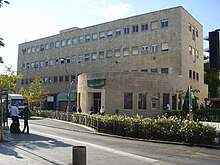Ossip Klarwein
Ossip (Yosef) Klarwein | |
|---|---|
יוסף קלארווין | |
| Born | Ossip Klarwein 6 February 1893 |
| Died | 9 September 1970 (aged 77) |
| Nationality | German-Israeli |
| Occupation | Architect |
| Children | Mati Klarwein |
Ossip (Yosef) Klarwein (6 February 1893 – 9 September 1970) was a Polish-born German-Israeli architect who designed many works in Germany and Israel. Between 1921 and 1933 he was employed with Johann Friedrich Höger, and became chief design architect. Klarwein was an important representative of Northern German Brick Expressionism and of modern architecture in Israel.[1]: 294
Life
Germany
Klarwein was born in
Mandatory Palestine / Israel



In 1934, Klarwein emigrated with his non-Jewish wife Elsa (née Kühne), an opera singer, and their son Mati during the Fifth Aliyah to the British Mandate of Palestine, because they saw no future in Nazi Germany.[1]: 295 Klarwein changed his first name from the Slavic name variant Ossip to the Hebrew form Yosseph.[1]: 295 In Haifa, Klarwein became an independent architect.[1]: 295
Most of his works are public and commercial buildings, as well as development plans for cities and neighborhoods scattered throughout
Works
- Church at Hohenzollernplatz, Berlin (1931–1933)
- Wichernkirche, Hamm, Hamburg (1933–1934)
- Qranot House, Hadar HaCarmel, Haifa (1936)
- Zina Disengoff's tomb, Trumpeldor cemetery, Tel Aviv (1937)
- Shaul Tchernichovsky's tomb, Trumpeldor cemetery, Tel Aviv (1945)
- Kiryat HaMemshala (Government complex), Jerusalem, with Richard Kauffmann and Heinz Rau (1950)
- Mount Herzl and Theodor Herzl's tomb, Jerusalem (1951)
- Hebrew University of Jerusalem, Givat Ram campus master plan (1953)
- Dagon granaries, Haifa (1953–1966)
- The Knesset, Jerusalem (1956–1966) together with Shimon Powsner, Dov Karmi, Ram Karmi, Bill Gillitt, and Dora Gad (interior design)[6]
- Israeli pavilion at the Brussels World's Fair(1958)
- Beit Zvi, Ramat Gan
- Tel Aviv Savidor Central railway station, Tel Aviv
- The old Jerusalem central bus station, Jerusalem (demolished)
References
- ^ de).
- ^ a b Susan (Sheila) Hattis Rolef: משכן הכנסת בגבעת רם: תכנון ובנייה. In: קתדרה, Band 96 (July 2000), English, "The Competition and its Results, mid-1956 to mid-1958", auf: Knesset English Homepage, retrieved 11 April 2015 .
- Berlin State Museums(in German).
- ^ Susan Hattis Rolef. The Knesset Building - Architectural Highlights
- ^ Lotte Cohn: Richard Kauffmann, Architect and City Planner. [Richard Kauffmann: Architekt und Stadtplaner (de.), Jerusalem: Brief an Bath-Scheva Kauffmann, 1978; English.], Monika Iacovacci (Übs.), auf: Richard Kauffmann: Architect and Town Planner – Biography, Retrieved 11 April 2015.
- ^ "The full story of the Knesset building". Knesset homepage. Retrieved 1 December 2021.
External links
- The Knesset Building in Giv'at Ram: Planning and Construction
- The Knesset Building - Architectural Highlights by Dr. Susan Hattis Rolef
